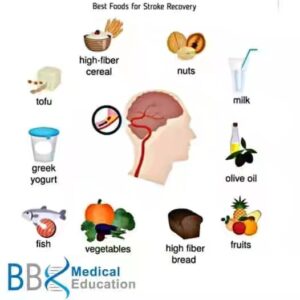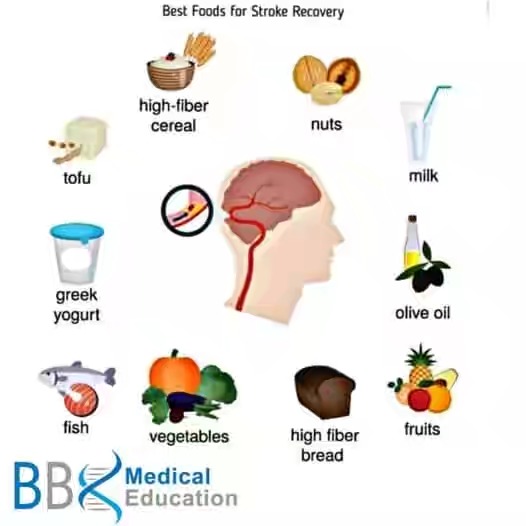Diet Meal Plan, Food Timetable + Nigerian Foods for Stroke Patients, understanding the Food for Stroke Patients in Nigeria.
Let us talk about the Nigerian foods for Stroke Patients
Introduction:
Eating well after a stroke key to recovery.choosing healthy foods can help control blood pressure,body weight,reduce a person’s risk of having another stroke,and may help with the demand of stroke therapy and other daily activities.
*What can stroke patients eat*
Enjoy a wide variety of nutritious foods from these five food groups every day:
Plenty of vegetables of different types and colours, legumes and beans.
Fruit, grain (cereal) foods, mostly wholegrain and high fibre varieties such as breads, cereals, rice, pasta, noodles, polenta, couscous, oats, quinoa and barley.
*What should stroke patients avoid*
* Eat Better Foods :
Choose lean proteins and high-fiber foods. Stay away from trans and saturated fats, which canclog your arteries. Cut salt, and avoid processed foods. They’re often loaded with salt, which canraise your blood pressure, and trans fats
*Food is good for stroke patients*
* Fruits and vegetables
Foods high in potassium, such as sweet and white potatoes, bananas, tomatoes, prunes, melon and soybeans, can help you maintain ahealthy blood pressure, which is the leading risk factor of stroke. Magnesium-rich foods, such as spinach, are also linked to a lower risk of stroke.
*What to eat when recovering from a stroke*
• If you have suffered a stroke, you may need to modify your diet to lower blood pressure and cholesterol and improve your cardiovascular health. an expert from Johns Hopkins School of Medicine, states that “the recommendations from the American Heart Association (AHA) for reducing cardiac risk are the same for reducing stroke risk.”
So, in addition to eating foods that lower blood pressure and cholesterol, you also need to choose ones that help you maintain a healthy weight to reduce your risk of suffering another stroke. Besides the preventative power inherent in improved eating habits, a nutritious diet can help you stay energized during physical and occupational therapy and other daily tasks while you’re recovering from a stroke.
*Effects of a stroke on your diet*
After a stroke, maintaining healthy habits can be challenging. There may be a risk of poor nutrition or failing to take in enough nutrients via eating and drinking, leading to unhealthy weight loss and slowing your ability to recover. Poor nutrition can be brought on through a variety of stroke complications.
It is common to experience neurological symptoms such as dysphagia or difficulty swallowing, as well as limited arm and hand movement, which may limit your ability to use eating utensils like knives and forks.
• Cognitive deficiencies may also interfere with your ability to eat properly by causing you to forget to do so at regular intervals. Stroke may also affect the part of the brain responsible for appetite, reducing your desire to eat.
*Benefits of a healthy diet after stroke*
• It is important to consume a diet low in fat and sodium and high in fruits and vegetables to avoid risk factors for another stroke, such as high cholesterol, blood pressure, and body fat.
• It is also possible that some foods may interact poorly with medications you begin taking after suffering a stroke, so be sure to check with your doctor or pharmacist before beginning a new nutrition program.

One helpful tool to get started on your new nutrition plan is the which is designed to help you determine your energy and nutrient needs, track them, and help you succeed while on the road to recovery.
• Each patient has different requirements, therefore it is important to consult with your doctor about you eating habits on a frequent basis.
*Tips for healthy diet*
1} Read Food Label
• Check the label. Legally, most foods must have standard nutrition facts printed on their labels. You may be surprised to see the details on some of your favorite processed foods.
• Watch out for things like sodium, sugar, and fat when reading the nutrition facts on your food. Make sure you get enough protein and vitamins.
2} Cut Back on Cholesterol
• Keep your intake below 300 milligrams.
• Reduce the frequency and portion size of meat and poultry consumption, keeping to 3 ounces or fewer at a time. Trim visible fat or skin from meat if you do choose to eat it.
• Cut back on dairy products, including butter, and choose low-fat or nonfat options.
• Eliminate usage of lard, egg whites, and liver.
3} Limit Trans Fats
• Avoid products that contain hydrogenated (or partially hydrogenated) oils.
• Watch out for trans fats, which are included in processed or fried snack foods, stick margarine, and vegetable shortening.
4} Reduce Saturated Fat Intake
• Try to keep saturated fat to a maximum of 10 percent of your total caloric intake by avoiding whole milk and choosing lean meats and fish, as well as skinless poultry.
5} Cut Down on Fats in General
• Keep your fat intake to no more than 30 percent of your overall caloric intake.
• Broil or bake foods, as opposed to frying them, and use low-fat or nonfat condiments and dressings.
6} Eat a Variety of Foods
• Be sure that you are getting balanced nutrition and all of the vitamins and minerals you need from a variety of different foods. Eating one type of food just won’t cut it.
7} Eat Five or More Cups of Fruits and Vegetables Every Day
• Eat enough fruits and veggies every day and you may reduce your risk of stroke.
8} Reduce Your Salt Intake
• To reduce the risk of high blood pressure, keep your sodium intake to under 2,400 milligrams per day. Try using herbs, spices, and other salt-free seasonings when preparing food.
9} Read Medication Labels
• Check cold, headache, and stomach medications for sodium levels.
10} Move the Salt Shaker Off the Table
• Move the shaker so you are not tempted to add more salt to your meals. Instead, try basil, coriander, paprika, chili, or black pepper to season food.
11} Have Healthy Snacks
• Keep properly portioned bags of washed and cut fruits and vegetables on hand for healthy snacking.
12} Eat Fish
• Have a meal including fish a minimum of two times per week. Fish is one of the recommended Nigerian foods for stroke patients.
13} Eat Lean Proteins
• Stick to lean meats and poultry, and avoid using saturated or trans fats when preparing them.
14} Choose Low-Fat or Nonfat Dairy Products
15} Avoid Added Sugars
• Cut down on sugar. The AHA recommends that no more than half of your discretionary calories (approximately 100 calories for women and 150 calories for men) come from added sugars.
16} Use Fresh Ingredients
• Make use of fresh, unprocessed ingredients to ensure you don’t end up with added sugars or sodium in your food.
17} Limit Frozen Entrees
• Select frozen entrees with no more than 600 milligrams of sodium, and eat no more than one of these per day.
18} Choose Low Or No-Sodium Snack Foods
• Pick natural snacks, such as plain popcorn or fruits and vegetables, as they are the best options.
19} Keep a Food Diary
• Keep track of what and how much you are eating with a food diary.
20} Use Smaller Bowls and Plates
• Utilize smaller bowls and plates to help keep portion sizes under control.
*Getting the right Nutrition for stroke patients*
• You can add variety to your meals by picking vegetarian protein sources that include beans, peas, nuts, and seeds, which have the added benefit of providing healthy fats like omega-3s.
• If you are going to rely on vegetarian protein sources, be sure to check with a dietitian to learn how to pair them together so that you are getting all of the essential amino acids.
When looking for grains, always choose the least-processed options. Whole grains, such as oatmeal and brown rice, are the best possible choices.
• Look for dairy options that come in low-fat or nonfat varieties, or choose non-dairy, calcium-rich foods. Fruits and vegetables come in colors that represent the nutrients within them, so be sure to eat the rainbow to get the most balanced meal possible.
Hypertension is the major risk factor for stroke globally, always have your blood pressure checked.
Apart from the title of article which was edited, this whole article is the intellectual property of *BB Medical Education*





















